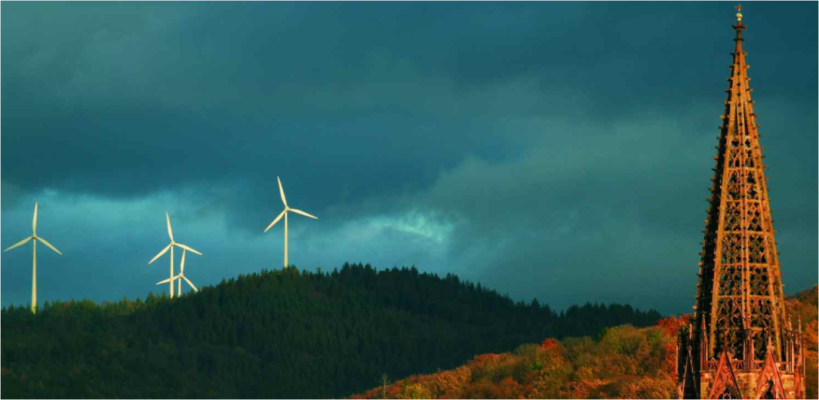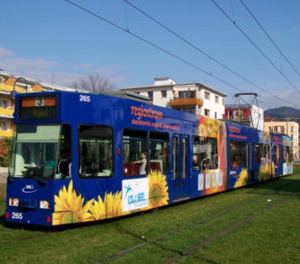A UConn “Sustainability Exchange” Experience – Renewable Energy in Freiburg, Germany
This is the third in a series of blog posts by Rich Miller, UConn’s Director of Environmental Policy, comparing and contrasting aspects of environmental sustainability at Freiburg University (Albert Ludwig University at Freiburg or Freiburg Uni) and in the “Green City” of Freiburg, Germany, with similar sustainability aspects and metrics at the University of Connecticut (UConn) and its main campus located in Storrs, within the small town of Mansfield and the rural surroundings of northeastern CT. Rich received a professional staff travel grant from UConn’s Office of Global Programs and used it to visit Freiburg over a two-week period in July 2012 for this international sustainability exchange program.
What would you expect from Germany’s “solar city?” Taking advantage of the fact that it’s located in the sunniest region of the country – a relative distinction compared with the often cloudy and cool northern Europe – Freiburg has installed more solar panels than any other city in Deutschland, and more than many countries in Europe. Dr. Stefan Adler, the enthusiastic Director of Uni Freiburg’s Center for Renewable Energy, explained to me how the city’s green reputation and passion for solar energy was borne during the 1970s from a grassroots fight against a proposed nuclear facility, which was planned for an area just northwest of Freiburg, along the Rhine River. The protestors, led by local farmers, prevailed and the nuclear plant was never built. Today, the long-time Green Party mayor, Dieter Salomon, remains a popular incumbent, and solar panels, wind turbines and small hydro-electric facilities have been part of the cityscape in Freiburg for years. The anti-nuclear sentiment remains strong among the general population and, decades later, is still part of the sustainable energy message communicated by the mayor’s office and local businesses.
Solar panels are on many buildings in Freiburg, like this photovoltaic array on the side of an office building near the main train station. Freiburg has more than 12.3 MW of solar PV (mostly roof-mounted), which generates more than 10 million kWh of electricity a year.
Old meets new: New wind-power turbines on the edge of the Black Forest overlook Freiburg and the 800-year old Munsterplatz cathedral. A total of five Freiburg wind mills produce 14 million kWh per year and two more are planned. (F. Breyer, Büro der Bürgermeisterin, Freiburg)
A few small hydro-electric facilities can be seen along the Dreisam River, which flows across the southern portion of the city. Freiburg’s hydro power produces nearly 2 million kWh a year and 80% of the electricity used to run the regional trams. (F. Breyer, Büro der Bürgermeisterin, Freiburg)
I met with Dr. Franziska Breyer, the city’s environmental director, in the town hall or Rathaus (a German word with an unfortunate double entendre in English), to talk about Freiburg’s plan for achieving carbon neutrality by 2050. She was busily preparing for an important meeting of a town commission that evening, when she was hoping for the board’s approval to raise the bar on Freiburg’s interim carbon reduction goals. Dr. Breyer, who is a forester by training, and a former faculty member at Freiburg Uni, was also pressed for time because her job title and management portfolio had recently been expanded to include youth, schools and education. With that kind of addition to her workload, I was grateful that she could spend any time meeting with me, much less an hour, and I appreciated the presentation materials she gave me from her latest annual report to town officials: “Approaches to Sustainability – traffic policy, climate protection and urban development planning in Freiburg.” Many of the facts and figures cited in this report are from these excellent presentation materials.
In addition to the governmental, residential and commercial building owners who have installed solar arrays throughout the inner city and surrounding village districts, Freiburg University has also made a large investment in roof-mounted solar PV. On the university’s 550th anniversary in 2007, their Rector (chief academic official) announced a “Solar Uni” initiative with the ambitious goal of installing 550 kW of solar panels on campus over the next five years. Using government incentive programs that ensure a guaranteed rate of return for solar investors, many people, including students, faculty and staff, actually acquired equity shares in these on-campus installations and, by 2012, the Solar Uni initiative achieved its lofty goal. In turn, these same incentive programs stimulated the growth of German solar developers and manufacturers, several of which are clustered in and around Freiburg.
Solar PV and thermal technology is not only a significant source of power and heat in Freiburg but also has stimulated an industry cluster that is important to the regional economy. (Photo of Solar Fabrik office building courtesy of F. Breyer, Büro der Bürgermeisterin, Freiburg)
Freiburg combines its long-standing commitment to renewable energy with more recent conservation-focused laws and resolutions proclaiming goals and mandates like: (i) zero-carbon development on land that it owns, (ii) more energy efficient replacement windows on existing homes, and (iii) low energy standards for new homes. For example, in the Green City’s Vauban eco-district, which was established in the mid-1990s through the redevelopment of the barracks in a former French military base, homebuilders must ensure that new residential buildings waste no more than 65 kWh per square meter annually – a fraction of the average for most homes in northern Europe. Walking down the main street in Vauban, along the two tram lines leading into and out of Freiburg’s inner-city, one sees solar panels, playgrounds and small parks everywhere. Cars are prohibited within Vauban’s pedestrian village, which also gets the bulk of its electricity and thermal energy from a centralized combined heat and power biomass plant.
As I left the eco-district and headed back to Freiburg’s inner-city on the tram, I checked “Vauban” off the list of destinations on my official Green City tour map. It had been well worth my time and the four euro roundtrip tram fare, but I was thankful that I hadn’t paid 180 euros for the two-hour guided tour. Eco-tourism is a big business in Freiburg, including group tours of man-made features, like Vauban, and nature excursions to places like the Black Forest.
Solar panels are on the rooftop of virtually every apartment building in the Vauban eco-district. Envisioning an affordable, sustainable energy community, Freiburg developed Vauban in the early-1990s by converting the barracks of a former French military base.
Vauban’s biomass plant, combined with solar, produces heat and power for the entire eco-district. (F. Breyer, Büro der Bürgermeisterin, Freiburg)
Solar panels are everywhere in Vauban, including on the rooftop of this café and commercial building.
(Next – Part 4: Freiburg Uni Sustainability)









Pingback: Sustainability Exchange – Part 2: Bicycle Transportation | Office of Environmental Policy
August 14, 2012 at 12:08 pm
Reblogged this on UConn EcoHouse.
July 11, 2017 at 3:32 am
What’s up it’s me, I am also visiting this site regularly, this web page is really nice and the users aree actually sharing good
thoughts.